

The Smitswinkel troop forage ahead of a sign saying "Please prevent veld fires". At least 12 members of the Tokai troop, one of the four Northern troops most affected by the fires of March 2015, have died or been put down as a result of injuries. A further 8 injured adult males were recently announced as having "distinctive round red patches on their rumps". (see below)

TOKAI BABOON NUMBERS CONTINUE TO DECLINE FOLLOWING BURNS SUSTAINED IN MARCH 2015 FIRE
- 12 OF 73 MEMBERS OF TOKAI TROOP NOW CONFIRMED DEAD
Tokai Troop Prior to fire 73 baboons
March 5 at 17h00
Baboon Technical Team situation report states:
* Three critically injured baboons euthanased.
* Four dead baboons found as charred carcasses.
* Seven injured baboons continue to be assessed.
66 baboons
March 9 at 14h00
Baboon Technical Team situation report states:
* Four critically injured baboons have been euthanased
* Four dead baboons found as charred carcasses.
* One critically injured infant – assumed to be dead
* Seven injured baboons continue to be assessed.
64 baboons
March 19
HWS Service Provider states:
62 baboons (no explanation of 2 additional deaths)
March 24
Baboon Technical Team situation report states:
"The final tally of dead and recovering fire-injured baboons in the Tokai Troop is as follows:
* Four critically injured baboons have been euthanased.
* Eight dead baboons found deceased as a result of the fire (either charred or died of their injuries shortly after the fire);
* Eight adult male baboons continue to be monitored for distinctive round red patches on their rumps. The result of fire burn, these red patches are now scabbing and veterinarians confirm that they will heal.
The Tokai troop is now confirmed to have 61 baboons in the troop – down from 73."
61 baboons
Note: Report also stated "The Zwaanswyk Troop has lost a juvenile and this is suspected to be from smoke inhalation. The troop now has 26 members. "
19 March, 2015
The Baboon Technical Team confirmed the following situation in the Tokai Troop on Thursday March 5 at 17h00 following the devastating fires affecting the Cape Peninsula:
* Three critically injured baboons euthanased.
* Four dead baboons found as charred carcasses.
* Seven injured baboons continue to be assessed.
The BTT team, veterinarians and animal welfare professionals left the site in the Tokai Forest on account of poor visibility and smoky conditions at 17h30.
The Tokai troop originally had 73 baboons, as of 9 March, 2015 another critically injured baboon had been euthanased and an infant was presumed dead, leaving 64 baboons.
The service provider tasked with looking after the baboons has stated (18 March 2015) there are 62 baboons in the Tokai troop, but did not give details as to whether the additional 2 deaths occurred in the group of seven injured baboons being assessed. While protocols allows for provisioning in situations like this, additional feeding was decided against.
To date, 19 March, 11 baboons of the Tokai troop of 73 have officially been confirmed to have died during and following the fire, leaving a total of 62 (for details see Bab-blog - Updates on what is happening).
MARCH 2015 FIRES IN THE CAPE PENINSULA AFFECT THE BABOONS
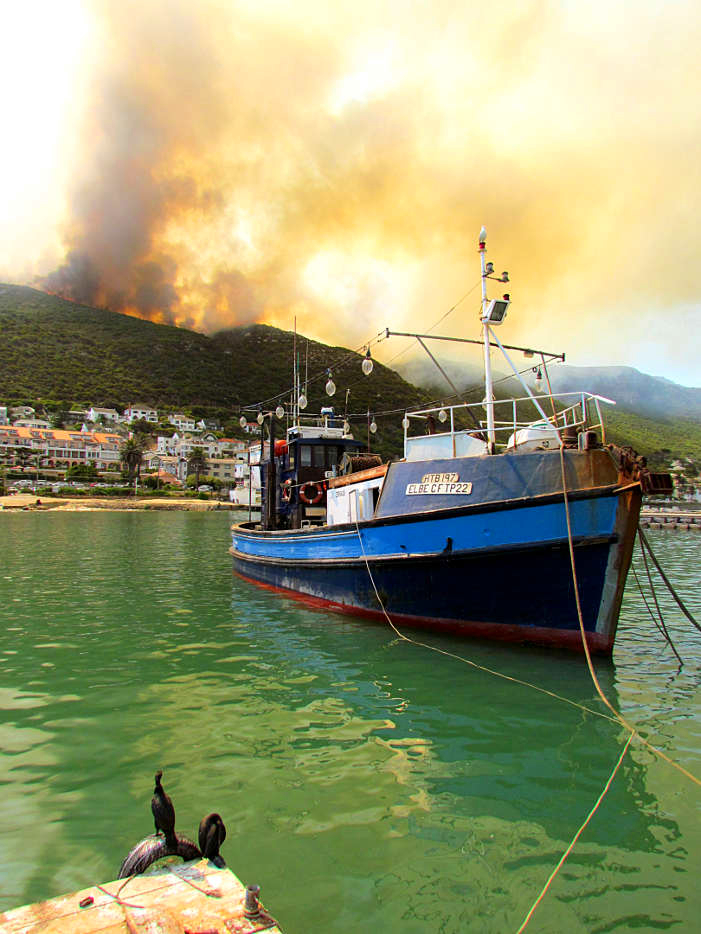
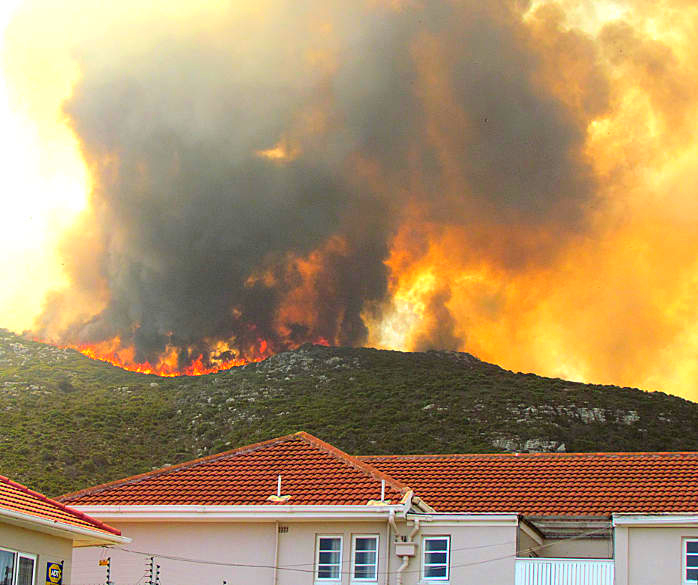
Fire rages on mountains above Kalk Bay on Day 3 of the fire that began in Muizenberg on 1 March 2015, 3 March was also the hottest day in Cape Town for a century.
The Cape had seen a large number of fires over the summer, but on 1 March 2015 the Cape Peninsula began to experience fires over the next few days that spread from the "Muizenberg fire" starting in Pecks Valley above Boyes Drive. Fueled by strong winds, the fire flared up in the early hours of 2 March 2015 and spread rapidly.
The fire was deemed the worst in years and affected areas such as Muizenberg, Lakeside, Ou Kaapse Weg, Noordhoek, Kalk Bay, Clovelly, Constantia, Tokai, Hout Bay. (Fires also started in the Cape Point Reserve. On Saturday 7 March fires broke out on the Scarborough and Misty Cliffs mountains.)
Helicopters dropped buckets of water on the flames. Firefighters battled the fire, often on steep terrain, supported by volunteers and sustained with donations of food and drink from the public.
Over 5500 hectares of vegetationwere affected.
Around a dozen buildings were burnt by the fires, three completely gutted, residents losing everything.
Wildlife including tortoises and the baboons paid a heavy price.
Of the 10 managed troops, 4 live in the Northern Peninsula.
The Tokai troop, consisting of 73 baboons, was particularly affected by the fire.
Concerned members of the public were anxious to find out how the baboons, including those in the Northern Region had fared in the intensely burning pine forests of Tokai.
The Baboon Technical Team reported on 5 March, 2015 that the carcasses of four dead baboons were found, three critically injured baboons were euthanased while seven injured baboons continue to be assessed.
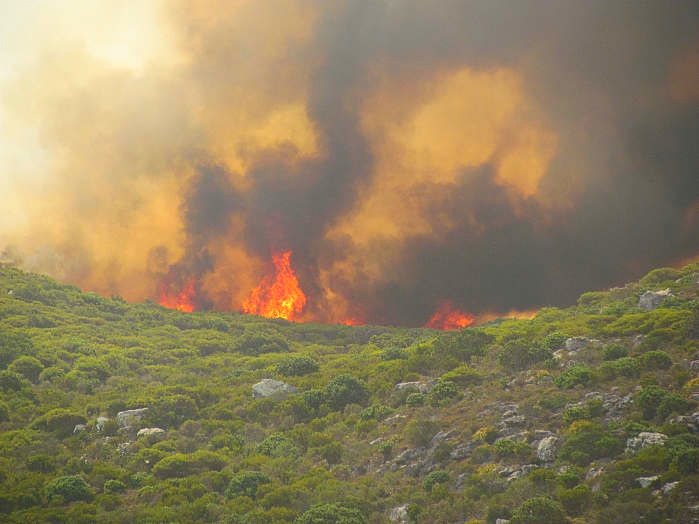
Strong winds helped fan the fierce fires, burning vegetation such as fynbos (above) and pine plantations, home to some of the baboons .
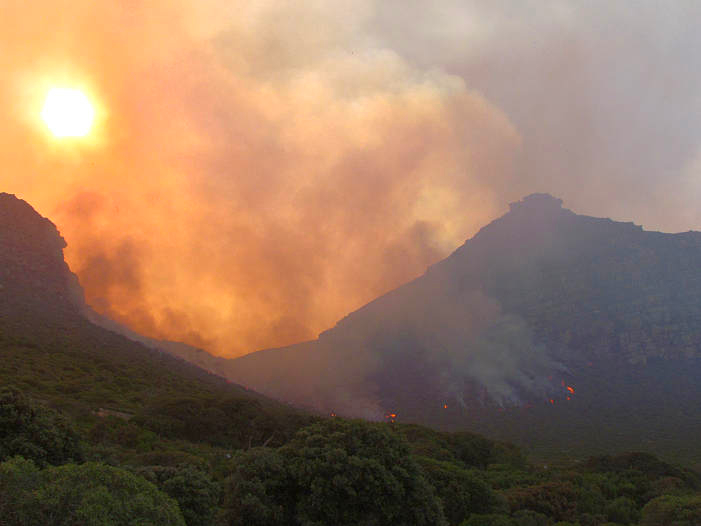
Hotspots, like these seen on 3 March on mountain above Muizenberg (top) and the mountain behind Clovelly (bottom) were monitored for flare ups. The fire on the Clovelly mountain did subsequently flare up, moving closer to the residential area.
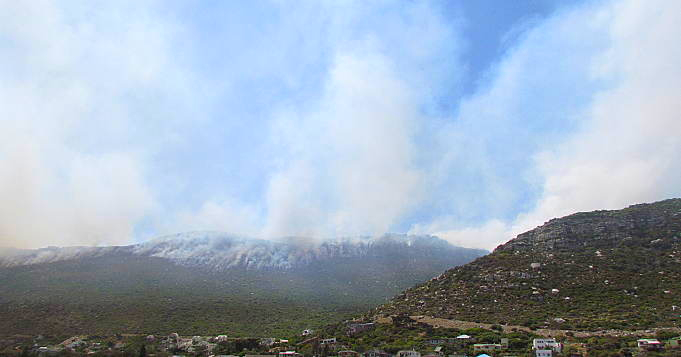
NOTE: As the fires swept through the Peninsula, a sense of community was noticeable - donations including food and drink were taken to drop off points and many expressed their appreciation for the firefighters in the air and on the ground who fought the fire, risking their own lives and safety to protect others and their property.
No human lives were lost while the fires swept through the Peninsula. However, on Sunday morning, 8 March, 2015, a pilot, flying a Working on Fire helicopter, Willem Hendrick ‘Bees’ Marais, tragically died in a helicopter accident while fighting a flare up of a fire in the Cape Point section of Table Mountain National Park.
He was paid tribute to as a pilot with vast knowledge, experience and skill.

23 OCTOBER, 2014
It has been officially confirmed that Merlin SWB1 (below) of the Smitswinkel troop was culled in early October 2014.
This brings the total of baboons known to be culled since the start of 2014 to at least nine.
DG1, DG9, DG10, GOB8, GOB9, TK35,TK38, TK39, SWB1
According to a report in local newspaper, the False Bay Echo, in response to a question they asked if any more baboons were "given the go-ahead to be put to death" by the Wildlife Advisory Committee, they were told by the City of Cape Town's Mayco member for energy, environmental and spatial planning that "Any euthanasia of any individual baboon by the baboon management conservation authorities is not released by the Baboon Technical Team."
Therefore, at this stage, with four baboons having been culled between 29 August, 2014 and the beginning of October and three months until the end of the year, it can only be speculated as to whether the total of culled baboons for 2014 will approach or equal 17, the total for each of the two consecutive years of 2013 and 2014.
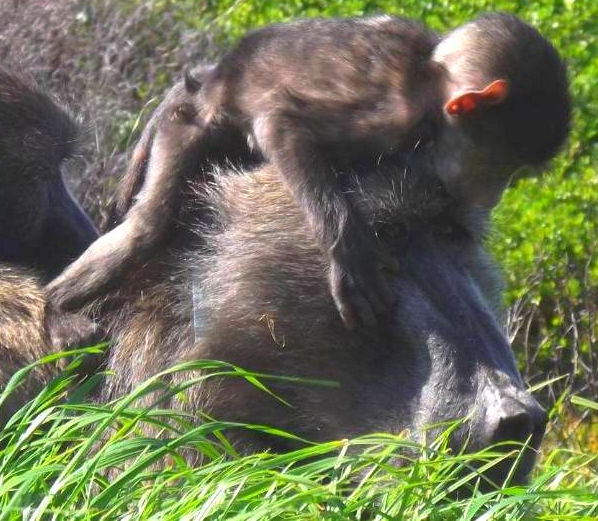
Merlin with baby of Shortcut on his head. Photo supplied
Some of the Da Gama Park baboons culled in accordance with protocols or killed by humans, dogs or other reasons.
Some claim the baboons have no apex predators and this causes baboon problems on the Peninsula, yet as can be seen from this selection of male baboons, their deaths are most often the result of actions of humans or dogs.
Many people have lived successfully without baboon raids, including never having experienced a raid due to effective baboon-proofing, which points to the fact the problems with baboons lies elsewhere.
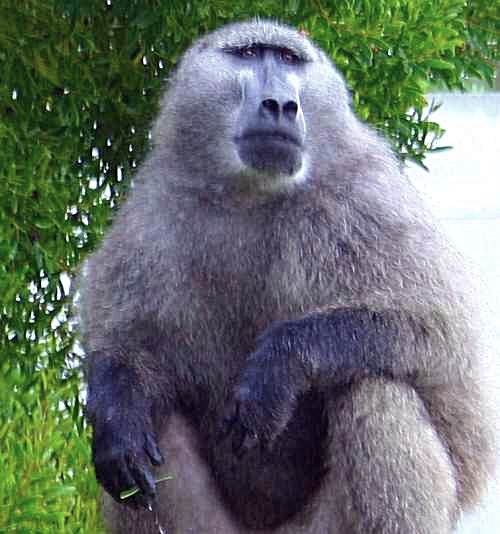
George killed by dogs 2011
Nosketi Put down after shot by resident 2011
Bafana (DG2) Disappeared 2011, had been seen with injuries

Peter (DG3) Culled 2012
Carpenter (DG3) Culled 2012
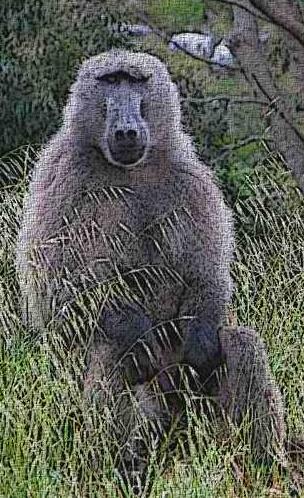
Quizzy Put down after attack by dogs and humans 2013
Mavula (DG5) Culled 2013
Calvin (DG7) Culled 2013
Naughty Boy (DG9) Culled 2014

Eddy (DG10) Culled 2014
Quondi (DG1) Culled 2014
OCTOBER, 2014
According to the September service provider report, not only was Quondi culled, so were GOB9 and TK39.
It was admitted Quondi was being chased away by the male Horace from Slangkop troop who became alpha after the two troops were forced together to remove the fission troop. Over the last year Horace also chased away the Da Gama maturing males Calvin, Naughty Boy and Eddy who also left for self preservation but were then targeted using the raiding protocols as being in the urban area and raiding and subsequently culled.
So far, according to the reports, 8 males have been killed in 2014 up till September according to management options. (A ninth, Merlin (SWB1), was killed in October). If three per month are killed in the remaining three months till the end of the year, this would equal the previous two years' totals of 17 each year.
Below are the codes/names of at least 51 Peninsula baboons known to be culled in terms of raiding protocols, the first introduced with scientific input in August 2009, the second in June 2010.
The 11 managed troops outside Cape Point Reserve currently consist of around 380 baboons. All in all on the Peninsula there are just over 500 baboons.
The 51 culled baboons killed between the second half of 2009 and October 2014 are represented below in their troops. Missing sequential codes may include those who are still alive or else have been attacked by dogs or humans and put down. For instance, in the Da Gama Troop, DG2 disappeared and DG8 was put down after being attacked by humans and dogs. (Some baboons, particularly juveniles and infants who have died, may have neither code nor name.)
TK Tokai (Currently 4 troops)
Sol, John Travolta, TK1, TK5, TK7, TK8, TK9, TK10, TK12, TK14, TK17, TK18, TK20, TK21, TK22, TK23, TK26, TK27, TK29, TK32, TK35, TK37, TK38, TK39
GOB Groot Olifantsbos
GOB1, GOB2, GOB3 GOB4, GOB5, GOB8, GOB9, Sparkles
SWB Smitswinkel Bay
SWB1, SWB2, SWB4
WH/RH Waterfall/Redhill
RH1, WF1
DG Da Gama Park
DG1, DG3, DG4, DG5, DG7, DG9, DG10, DGF3, DGF8,
MC Misty Cliffs
MC1, MCF1
SK Slangkop
SK2, SK4. SK5

A Da Gama Park infant sits on its mother's shoulder.
23 SEPTEMBER, 2014
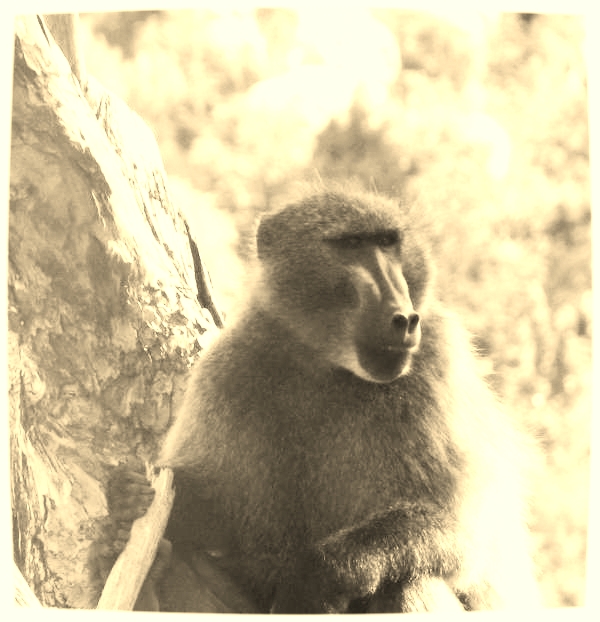
In the same month Eddy was culled on 1 August, Quondi was culled on 29 August, 2014. Quondi was longtime alpha male of the Da Gama Park troop until the troops were pushed together in 2013 in order to get rid of the fission troop for management reasons. (Removal of a fission troop also followed 2009 recommendations made by the head of BRU, Justin O'Riain at the baboon expert workshop, along with selective removal of various categories including age and sex.)
After this Horace began to be called the alpha male by the service provider, although Quondi continued to play a cohesive and protective role, including defending the young from Horace, who was not born into this troop but came from the neighbouring Slangkop troop. He initially joined the fission troop after the two males Peter and Carpenter were culled in 2012, another attempt to merge the troops, although the females resisted joining the main troop when by themselves, probably fearing for their young without protection. (Also, by now the males Quizzy and Mavula were no longer there to pose a threat to their young, with Quondi the only adult male.)
3 AUGUST, 2014
The Sunday Argus of 3 August, 2014 carried an article by John Yeld entitled "Are protocols being honoured?" following an incident on 20 July, 2014 involving a resident in the Firgrove area.
According to the article the man claimed he had been in his garden when he noticed a baboon walking in a relaxed fashion towards Ladies Mile. He also saw a man in the passenger seat of a white vehicle drive past slowly holding something "big" resting on his other arm or the window ledge. The resident heard bangs. On the fourth bang, he felt a sharp pain in his arm. He sustained a flesh wound measuring 5mm deep and about 3,8 - 5 cm long. Thinking someone was trying to shoot the baboon with an automatic weapon, he called the police. A HWS ranger who had been in the area was detained for questioning.
Since 2012 rangers have used paintball guns to chase the baboons. Many residents have complained about the way in which the baboons have been shot at and have questioned whether protocols are adhered to when multiple shots are fired. There have also been some instances where baboons are suspected of having been hit in the face or eye.
Residents have also complained about the negative interactions of some rangers, in particular field managers, with residents.
1 AUGUST, 2014
Eddy, (seen below being groomed by a female) was killed on 1 August, 2014. Will his death also have consequences for others in the troop, given that it leaves two adult males, Horace and Quondi? Horace is known to attack Quondi and other members of the troop.
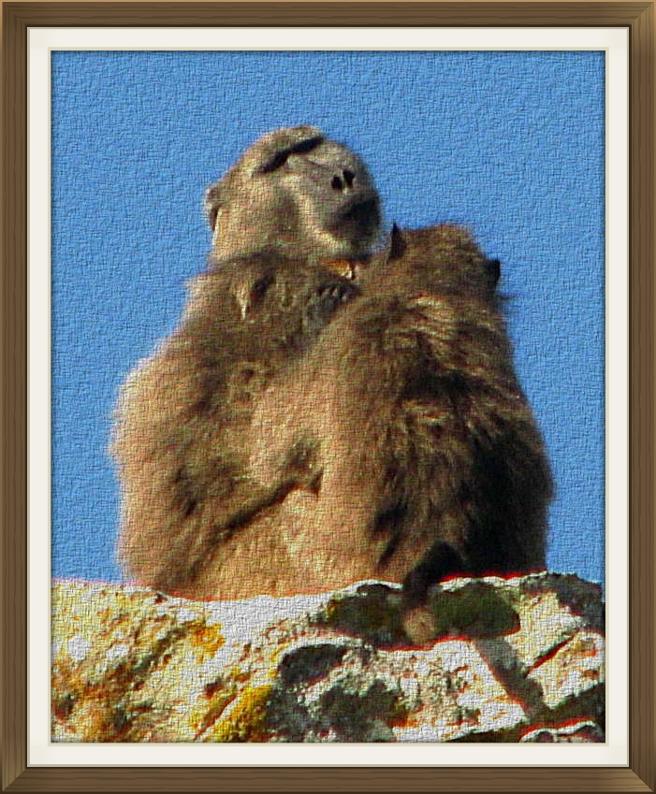
29 JULY, 2014
HWS awarded the contract for another three years. They will also serve a three month interim period from 1 August 2014.
Attempt made to trap Eddy, DG10 for cullng on Tuesday 29 August. Will be third of young maturing males to be culled in Da Gama Park troop in a year.
Independent scientific opinion is needed more than ever to give input on current management strategies.
Depletion of males last year led to infanticides when a male from a neighbouring troop entered and killed all 10 infants and a juvenile.
A similar episode of infanticide occurred following the culling of a Zwaanswyk alpha male, TK38, leaving the troop without any adult males and open for another male to enter and kill 3 juveniles and injure 2 more.
18 JULY, 2014
The False Bay Echo reported in "City hush on baboon tender" (False Bay Echo, July 17, 2014) that with the current baboon monitor contract expiring on July 31, 2014 and less than two weeks to go and with a delay in issuing the contract, there were concerns that there would be no baboon monitors from 1 August.
The contract has been cut by 20%. The article stated that the current service provider, HWS put in two tenders, its main one and an alternative one and that NCC, the previous service provider between 1 August 2009-30 June 2012 also tendered as did Mthembu's Construction (Pty) Ltd trading as Holistic Enviro Management.
(Note: a previous service provider, Baboon Matters, who do not support culling of the baboons and use non aggressive means of herding the baboons out the urban area, did not tender.)
Julia Wood is City of Cape Town manager of biodiversity management whom The Echo contacted.
"Asked why the City had taken so long to make a decision, Ms Wood said: "The City of Cape Town's Supply Chain Management Department is working through a number of processes."
In the meantime, "until the new tender is awarded, provision is being made to have the existing tender with Human Wildlife Solutions extended so that there is no disruption in services on the ground."
"City hush on baboon tender" (False Bay Echo, Michelle Saffer, July 17, 2014)
With or without baboon monitors or rangers, the importance of baboon proofing of house and bin cannot be over-stated in order to prevent attracting the opportunistic feeding baboons and then potentially and needlessly experiencing raids.
JUNE 2014
Adult males protect the young against attacks, a reason they have long canine teeth.
When alpha or adult males are killed in terms of the protocols, it can adversely affect other members of the troop in terms of deaths and injuries.
Note that after the culling of alpha male TK38 of the Zwaanswyk troop, (see May 2014 below) leaving the troop with no adult males to protect it, a male from another troop entered and killed 3 juveniles and injured 2 more.
While the service provider HWS puts the infanticide down as a "natural" occurrence, it again illustrates that when the alpha or leading males are culled, leaving the young baboons without protection, other members of the troop may also die.
This occurred in the Da Gama troop in 2013, with 11 babies and one juvenile dying after only one of three males, Quondi, was left to protect the troop - Quizzy had been put down after attacked by dogs and humans when the baboons were held for months in an area known to present a hazard due to vicious dogs, with several members also suffering dog attacks and another adult male, called Mavula culled because he was deemed a raider and resistant to pain aversion tools.
Quondi was also removed for several days due to dog injuries, leaving the troop without mature adult males, like the Zwaanswyk troop.
MAY 2014
Another two baboons were killed in May 2014, bringing the total of baboons culled in terms of protocols to at least 48.
Additionally, baboons have continued to die due to other causes, including human induced deaths (HID) or dog attacks.
Both baboons killed were alpha males, TK38 of the Zwaanswyk fission troop and GOB8 of the Misty Cliffs fission troop. In the case of TK38, the troop is left without any adult males to protect it.
In 2013 a depletion of males, including due to culling and attacks of dogs and humans led to a situation where a male from a neighbouring troop entered the troop and killed all 10 infants and a juvenile.
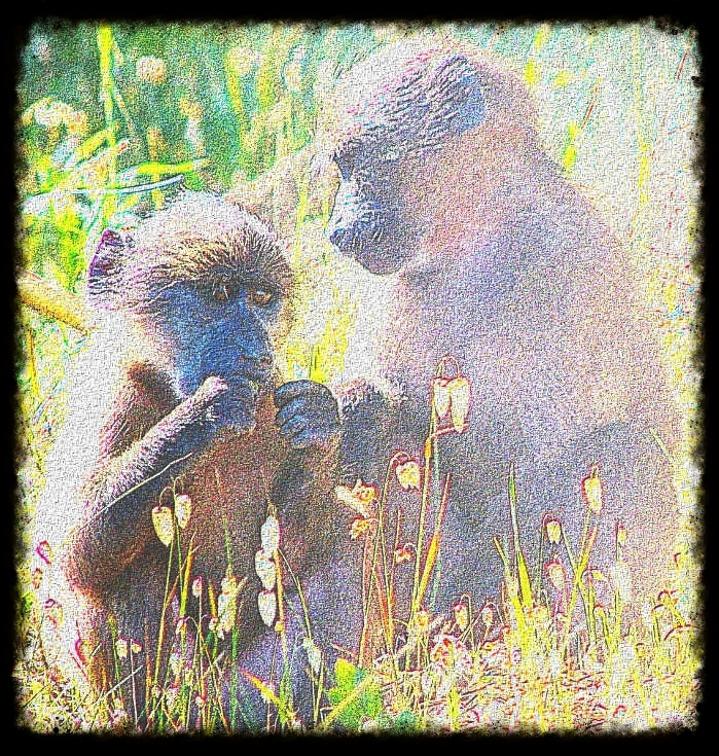
Often the very young baboons who are ostensibly excluded from paintballing by the SOPs and may be peacefulling foraging, react in fear to paintballs being shot - shrieking or running up trees.
April 2014
A Tender has been advertised by the City of Cape Town for a service provider to carry out baboon management on the Peninsula.
Tender Closing date 8 May 2014.
It is for R2 million less than current 2 year contract afforded to HWS since August 2012.
During this time residents have objected to controversial pain aversion tools consisting of paintballs, with pepperballs, pepperspray, rubber and plastic balls also permitted according to December 2012 Standard Operating Procedure.
'Raiding' baboons who have been deemed 'resistant' to pain aversion tools have been killed.
A Master's thesis by an overseas researcher, on the Peninsula between September and December 2012, details her being told by an 'informant' that a male baboon can take up to 30 paintball hits in an episode when attempting to run past rangers.
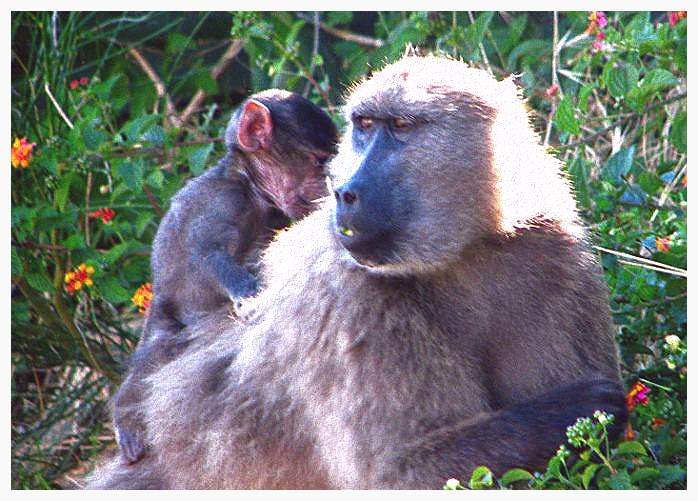
March 2014
First the dispersing males were targeted as problem raiders in 2009 in terms of the dispersing male and repeat raiders protocol, then other adult males including alpha males were killed according to the June 2010 protocol to reduce the frequency and severity of raiding behaviour amongst Peninsula baboons,
Maimed baboons were subsequently described as the worst raiders in 2013, some were culled.
More recently in February 2014 females have been accused of leading baboons to raid.
If deemed to be problem raiders, will more females now also be killed?
Within the context of baboons being in the proximity of the urban area, all baboons of independent age can "raid" or eat available food.
Baboon proofing prevents raids.
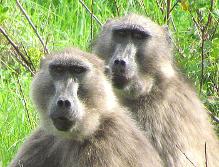
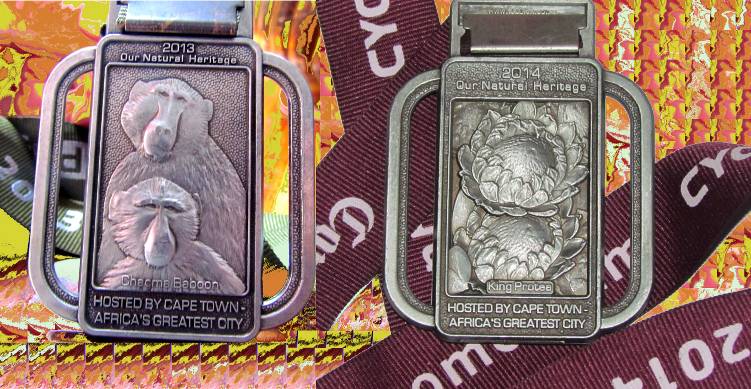
The Cape Argus Pick n Pay Cycle tour medal of March 2013 depicted Chacma baboons as "Our Natural Heritage" while the Cape Argus Pick n Pay Momentum medal of 2014 showed proteas, part of the fynbos floral kingdom of the Cape, which forms part of the baboons natural diet. Cyclists may see baboons from various troops en route the scenic route passing Simonstown, Cape Point and Scarborough.
February 2014
Another Tokai baboon was culled in terms of the protocols on 17 February, 2014. TK35 was a former alpha male.
Tender advertised on City of Cape Town site closing date 8 May 2014 for a service provider to carry out baboon management on the Peninsula
TK35 was accused of raiding a popular tearoom in Tokai forest and the forest's picnic site and acting aggressively towards hikers.
According to an information release dated 19 February, 2014
TK35’s raiding history included a number of category 7 raids.It stated that these raids were considered to be particularly serious as they involved TK35 taking food
directly from people which "demonstrated TK35’s complete lack of fear for humans."
The current goals pursued appear to be to reintroduce a so-called "fear of man" in the baboons and to reduce or even eliminate raiding behaviour and stop older baboons teaching younger baboons raiding behaviour.
The argument has been made that killing alpha or leading males for raiding does not prevent or stop raiding, as other males simply take their place and in the context of availability of non secured human derived food, will also exhibit raiding behaviour. There is a hierarchical troop structure with priority feeding rights for high ranking baboons.
With the inherent opportunistic feeding behaviour of baboons, is the goal of trying to obtain troops of non-raiding baboons achievable?
Some of the males that have been cited as 'non raiders' have subsequently also 'raided'. The protocols focus on raiding behaviour, particularly if a baboon "chooses" to come into human space or presence, as a major reason for killing the baboons.
Similarly, the use of aggressive tools can be questioned - aggressive tools do not prevent raids. Baboons, in particular male baboons, have shown they are willing to risk the pain, breaking past rangers. The pain can be considerable, given multiple shots from paintball guns are fired with pepperspray, pepperballs, rubber balls and plastic balls permitted by SOPs. If deemed pain aversion resistant the baboons are killed.
The head of BRU, a main proponent of the aggressive tool method since 2009, towards the end of 2013 publicly stated that baboons are habituating to paintballing, something that even prior to paintballing being introduced, was warned would occur by others including co-founders of the unit.
Underlying his recommendations is that humans and baboons should have no contact. He is currently promoting electric fences around all baboon affected areas.
Residents who effectively baboon-proof can live for decades without raids.
An argument against culling alpha or other leading males in the troop is that this can and does cause troop disruption, fights and injuries. Infanticide may also occur once a new male takes over the troop.
Culling Naughty Boy leaves Eddy DG10 as the other young maturing male in the Da Gama troop that has only two adult males, Horace and Quondi. The knock on effects of the deaths of Quizzy and Mavula in 2013 were felt when a male from another troop entered and killed 11 young baboons.
Naughty Boy DG9 of the Da Gama Park troop was culled on 22nd January 2014, one of the two maturing males of the troop.
The charges generally brought against culled baboons include one or more of the following : raiding, entering property, especially when humans are present - even though doors and windows are not secured with baboon proofing - causing damage by breaking doors and windows, acting aggressively, even though this term is not satisfactorily defined and may be subjective, grabbing food.
The fact that baboons, in particular male baboons, have since the introduction of aggressive tools, been treated aggressively appears not to be taken into consideration as unnecessarily provoking aggression in them. Treating any animal aggressively may elicit a defensive response.
20 December 2013
The alpha male of the Misty Cliffs fission troop, Slumko or Slimkop (GOB5) was culled in November 2013 according to raiding protocols and because he like a growing number of other males is deemed pain aversion resistant. Yet paintballing is claimed to be a success.
Peter and Carpenter the two adult males of the Da Gama Park fission troop were killed in 2012 in an attempt to "remove" the fission troop. The females refused to join the main Da Gama troop and were instead subsequently joined by Horace who became the new alpha male.
Slumko's death left the troop without an adult male. Within days, GOB8, a male from the main Groot Olifantbos troop was attempting to join the Misty Cliffs troop.
28 November, 2013
Big Mama alpha female of the fission troop holds her baby while sitting on a rock overlooking Welcome Glen.
25 October, 2013
At the Range meeting of February 2012, on the future management of baboons, the head of BRU gave a presentation in which he advocated the two part plan of paintballing and electric fences.
Paintballing was introduced in July 2012 into all 11 managed troops. The process caused distress and pain to the baboons, was offensive to many residents as well as to monitor staff who had previously used shouts and whistles. (Many of these staff were subsequently fired.)
In 2013, meetings have been held in Scarborough and Kommetjie to attempt to promote electric fences to residents.
The People's Post reported on the Kommetjie meeting in October, quoting Justin O'Riain , head of BRU, as saying "The fence provides a good solution and can avoid issues like raiding and the euthanasia of baboons. "
Residents may be more wary of such promises after previously told at the Range how baboons being in the urban area was tantamount to a decrease in their welfare and paintballing could prevent them being injured or killed by residents.
Yet in reality residents have seen baboons physically and psychologically affected by the paintballing during the last 16 months. Paintballed from morning to evening. Pepperspray, pepperballs and even rubberballs and plastic balls allowed for in the SOPs.
Baboons have still come into urban areas, the Da Gama Park troops sleeping there. Baboons have still been hurt or killed by residents and dogs.
Baboons have also been culled for raiding because they have been in urban areas and when showing resistance to pain aversion tools.
So can paintballing be claimed as having been a success? Should residents believe that electric fencing will be a success?
With opinions on the efficacy or desirability of a fence already divided, residents should take care to investigate the promises regarding this "tool" and the effects it could have for them as well as the baboons.
If the fence is seen as the only option, then it is time to open the matter of baboon management strategies up to a wider range of expert opinion.
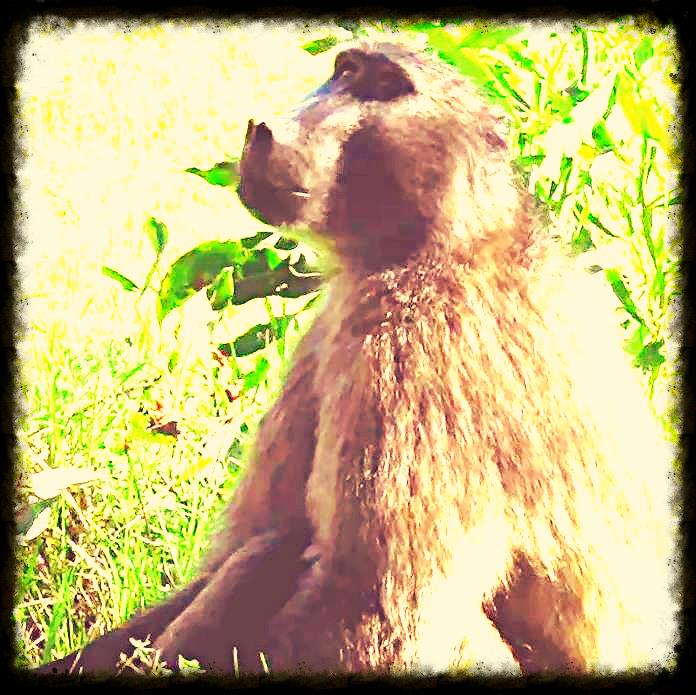
10 October, 2013
BTT press release states that two more baboons have been killed. Including DG7 Calvin (above), a young male of the main Da Gama troop, still approaching his prime.
Calvin was leaving the troop sometimes and raiding, given as a reason he was considered for culling. However, a reason for him leaving the troop was the alpha male of the fission troop Horace, now being held with the main troop in an effort to combine the two troops, was fighting with him. Calvin sustained injuries to the leg and face.
Calvin was also said to be leaving the troop at night to raid. This has been noted with other baboons. It is unusual behaviour as baboons roost at night.
However, reports of nocturnal incidents appear to coincide with the introduction of paintballing when some residents first noted baboons on occasion coming down from their roosting spots after rangers had left ,even in order to forage on natural vegetation.
September 2013
In September, TK13, a male from the Tokai troop, with a raiding history, was killed by dogs while WF1 from Simonstown Waterfall troop was culled in terms of the protocols. )
Justification for paintballing was presented as keeping baboons out the urban area - where they could be hurt by people and dogs. They continue to be hurt and killed by both.
31 July 2013
Between 27 April and 11 June an incoming male from the Slangkop troop, SK4 (Woody), proceeded to kill all 11 of the Da Gama Park infants plus one juvenile. The troop was reduced by a quarter to around 30.
The alpha male Quondi was unable to defend the troop on his own against the younger male. This followed shortly after the deaths of Quizzy in March 2013. He was put down after suffering an attack by humans and dogs. Quizzy had been attacked by dogs several days before by the same pitbull that attacked Quondi in February.
Also in March, Mavula, an adult male was culled according to raiding protocols and because he showed resistance to pain aversion tools, leaving Quondi alone as an adult male to defend the young against the intruder. (see entry below on Manuel, 23 May 2013.)
The baboons had been taken to the proximity of Ocean View, an area known to officials for the presence of vicious dogs and best avoided by the baboons, left there until the end of June. During that time Quondi suffered another serious dog attack on 28 May 2013, with injuries to lip, shoulder, leg and hand. A female was attacked by dogs, disappearing not long after and the body of another female was found, savaged by dogs.
11 July 2013
On 11 July 2013 the False Bay Echo reported that another far south baboon, "MC1, a male baboon from the Groot Olifantsbos "splinter" troop, Misty Cliffs" had "been killed by the joint Baboon Technical Team (BTT) which is made up made up of SANParks, CapeNature and City of Cape Town officials and service providers" on Friday July 5, 2013.
It reported that according to a press release "Aversive methods initially served to reduce his raiding frequency, but he has learnt that the benefits of raiding outweigh the costs of aversive conditioning, hence his recent return to bad habits."
An increasing number of baboons appear to be growing resistant to the pain aversion methods, and are then destroyed. This does again raise questions as to the efficacy of these methods and their continued use.
The head of BRU had recommended paintballing as his short term solution and electric fencing as his long term solution at the February 2012 meeting on future management of the baboons. Paintballing was implemented in July and has been very controversial.
Even prior to paintballing being introduced it had been stated by other scientists that it would not work as a long term method, nor did they recommend it at all given the possibility to cause injuries including to the eyes and to the young. Nevertheless, it was implemented without notification to residents.
MC1 of the Misty Cliffs troop was killed on the 5th. That evening members of the BTT and BRU addressed a meeting in Scarborough regarding implementation of the long term recommendation of the head of BRU, namely electric fencing.
The meeting was reportedly poorly attended by little over 20, many of whom were opposed to fences being erected.
16 June 2013
A female from the Da Gama fission troop, while allegedly taking part in a raid, was allegedly blinded by a resident spraying an unidentified substance on the 22nd May 2013.
The SPCA thought initially it was pepper spray. Not long after the incident, the service provider suggested among other substances, it was possibly oven cleaner.
A media release by the BTT (the Baboon Technical Team involved with management decisions on the baboons) stated:
"It was initially thought that pepper spray had been used in the altercation and that the baboon's loss of sight would be temporary.
However monitoring the baboon over the next week revealed that the baboon did not regain any sight. It is now speculated that the spray may have contained something more corrosive, such as oven cleaner."
Rather than not regaining any sight, it was claimed by others that she was able to see close by objects with eyewitnesses also reporting she was able to climb the height of the double storey building where the troop roosted.
It has been questioned whether she would have regained even more sight if allowed to properly recuperate at a holding facility, with a longer period to examine the eyes and determine the causative agent and effects plus possible antidote treatment being administered.
Also it has been suggested that given the loss of weight, being 'humanely fed' to regain strength rather than being 'humanely euthanised' upon capture 10 days after the incident may have been an option.
The baboon had, in fact, appeared easily accessible for capture for examination in the early evening of the 22nd, hours after the incident occurred. She was at the building where the baboons roost, in the ground floor area. (see photos where she is behind a safety gate, later entering an open door of the building itself where a ranger supervisor was situated.)
Several attempts to capture her later that evening outside in the dark by service provider staff failed.
An attempt by the SPCA to dart her the next day failed when the drug did not take effect.
She was subsequently lethally darted a week later on 31 May after a decision was reportedly made by the BTT and vet.
This decision was reportedly based on 10 days observation of the baboon in the field, stating she had lost weight.
It should be noted, however, that this baboon was regarded as a 'raider' described by one ranger the day after the incident as one of the 'terrible trio - always raiding'.
All baboons raid, male and female, young and old given the opportunity of available food. They are by nature "opportunistic feeders" enjoying a wide range of foods, including many of those also enjoyed by people, which is why baboon-proofing is required in baboon affected areas.
However, all fission troops, have since at least 2012, been renamed by scientists involved in giving input to management, as 'splinter' troops. They now claim these are 'formed specifically to raid'.
While presented as such by BRU and the service provider, HWS, also headed by a scientist, this definition is disputed as it merely seems to give support to removing the fission troops as was suggested by BRU in 2009 in a presentation entitled "reducing numbers".
Attempts have been made in the last year to "remove" this troop - first by removing the alpha male, Peter, by shooting him in August 2012, then shooting the other adult male, Carpenter in September.
The females failed to join the main troop as had been thought by the scientists.
However, as residents predicted, another male from a neighbouring troop which was also having contact with the fission troop, joined the troop as its new alpha male.
Horace, is also deemed to be a raider. As are other baboons in the troop.
Baboons with permanent injuries are now deemed to be the worst raiders, again a disputed allegation but one bringing their future into question.
Crookie, a female with a maimed hand is one of the three females Peter started the fission troop with in 2008, following his fierce fights with the alpha male of the main troop, necessitating his departure as a "dispersing male".
Previously BRU had defined a fission troop as the result of a successful dispersal by a male.
Aside from the ongoing killing of baboons according to the controversial protocols, residents remain concerned about the aggressive tools being used in their streets on the baboons and the effect on the baboons, both in terms of stress and possible injuries.
There was aggressive shooting on the day of the incident. Subsequently, one resident also complained of how on another occasion Horace was being fired on while on a roof, causing him to tumble off it. They then witnessed him limping.
While rangers continue to aggressively shoot at baboons using paintballs, pepperballs and pepper spray - and with some members of the public within the last month querying if rubber balls have also been used in this and other troops - the fact is, while these aggressive tools remain in use, questions and investigations regarding baboon injuries must now also include the possibility of injuries being caused by rangers themselves.
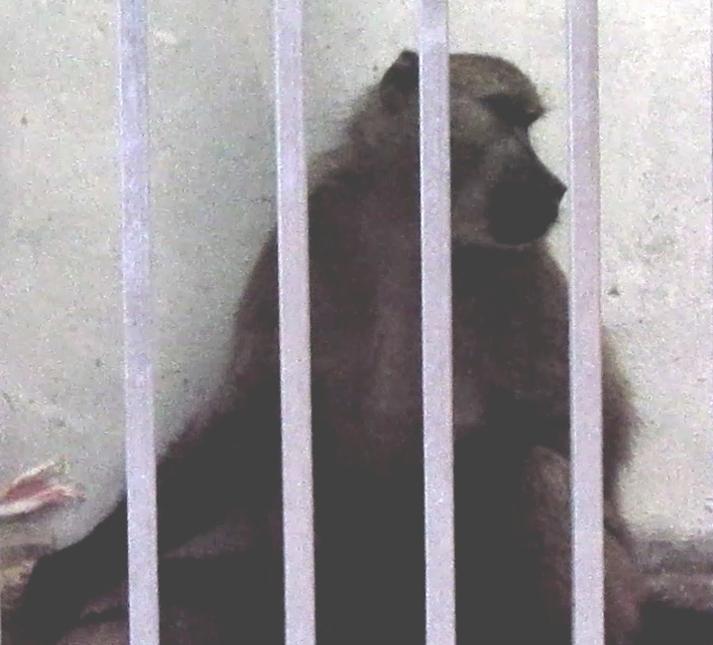

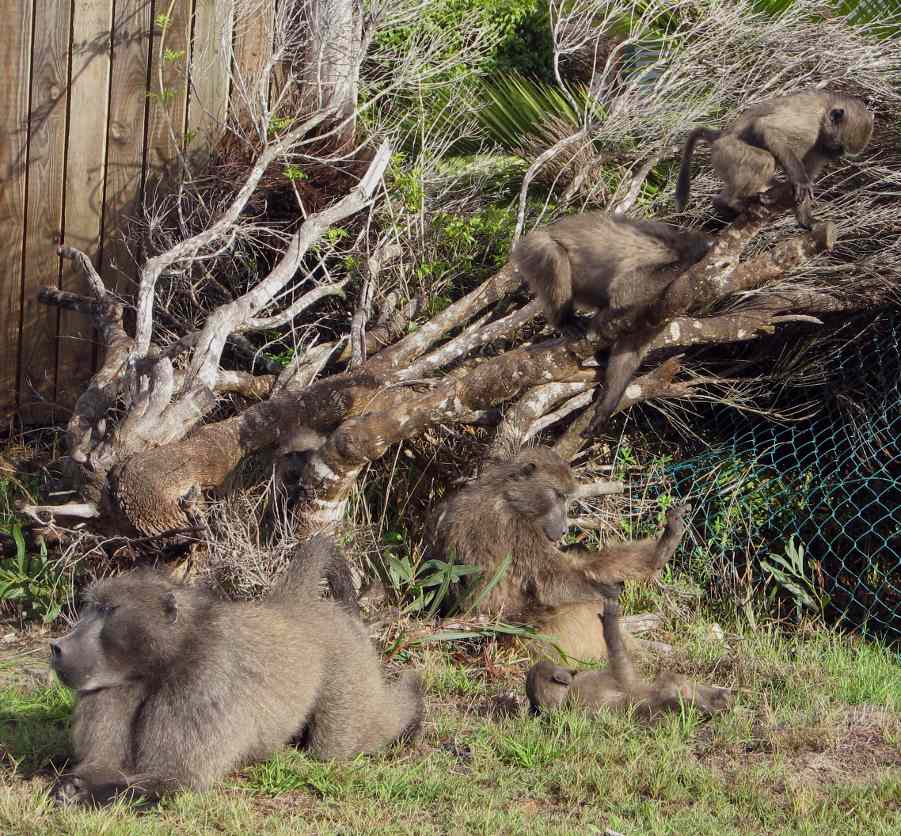
The young female who was blinded is one of the three young baboons seen here in 2009. Peter (lying in front) began the troop with 3 females in 2008. Rather than doing so in order to raid, as is now been claimed by local scientists giving input in baboon management decisions, it followed fierce fighting with the main Da Gama Park' troop's alpha male, George, necessitating Peter's departure as a "dispersing male".
Also seen is Crookie, the adult female in the centre who according to recent input by local scientists because she has a maimed hand is now deemed one of the 'worst raiders" , at risk in terms of the controversial protocol. Recently other females with 3 legs have been killed in terms of the protocols eg Tammy and Zameka. Describing fission troops (now renamed as splinter troops) as formed specifically to raid indicates an intent to remove these troops by claiming their only purpose is to raid. This is an erroneous assumption.
In 2009 there were 8 baboons in the troop, in 2012, there were 13. However with the various deaths of members of the troop, there are now 10 baboons, with Peter and Carpenter the other male, shot in August and September respectively.
Mavula, like other baboons, tagged for death, identifiable, under watch for "raiding", Now dead. Seen here being groomed by Tammy. Also killed in terms of raiding protocols.
27 May 2013
Mavula (DG5) and Tammy (DG3) both culled.
Mavula's death leaves the troop with alpha male Quondi. Chacma baboon troops are multi male troops. Since 2011 the troop's adult males have been decimated - George, dogs, Noskethi - shot, paralysed, put down, Quizzy - human attack with bricks and sticks and dogs, then put down.
23 May 2013
Manuel (below) was culled on 23rd May, 2013 - not given a chance of becoming alpha male. An increasing number of Peninsula troops are being left with only one mature male, which is not part of their normal troop structure and also decreases their safety given that males are for the protection of the troop and to maintain order in the troop.
"Who wants to be alpha male?"
Manuel (pictured above), along with Fingers, so-named because of his maimed hand, is one of two adult male baboons of the Smitswinkel troop officials consider as possible replacements for former alpha male, Force. Force never recovered after being darted for a routine collar battery change on 4 May, 2013.
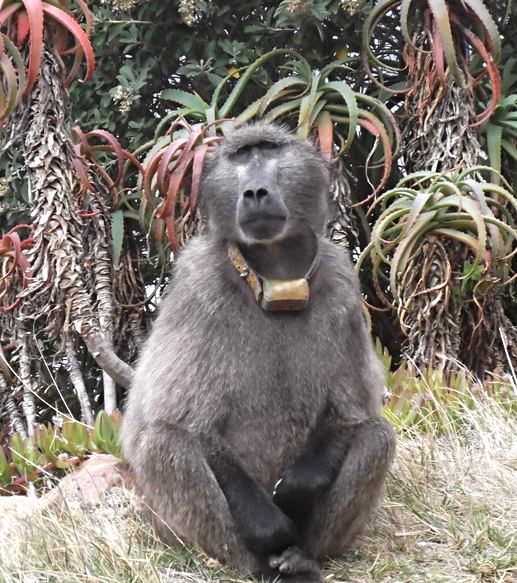

Force, alpha male of Smitswinkel Bay.
Force became leader of the troop after alpha male Fred was culled in March 2011, followed by Jimmy in July 2011. Prior to Fred being killed, Jimmy had been considered by officials as Fred's replacement, but was also put down in accordance with the raiders' protocol.
In June 2012 it was reported in the media that both Merlin, the 'grandfather' of the Smits troop, and Force were to be put down for raiding behaviour.Photo top above was taken a month before he died.
Photo below lies him lying in cage trap on the day he was darted for a routine change of battery in his collar. He never woke up.
Photos of Force supplied
A veterinary opinion on whether it is common for animals not to come around after darting
"Following the death of Force, the alpha male baboon of the Smitswinkel troop who did not recover after darting for a routine change of batteries in his collar, a retired vet with extensive experience in the development of safe anaesthesia in small animals was asked whether it was quite common for animals not to come around after darting.
The vet responded that his view on anaesthetic/sedation fatalities during 47 years in small animal practice (very few wild life patients) was “If the subject is alive, albeit in poor physical state, prior to being "doped" when the effect of the "dope" wears off it should be alive and in much the same physical state as it was at the outset .”
He stated “The animal does not "sleep" and "wake up", it is constantly fighting the drugs used by the vet. Death is likely to follow botched surgery, poor support (IV fluids are easy once sedated) and wrong anaesthetic selection unless at the outset the procedure was heroically undertaken despite knowing that the patient is as good as dead.”
“The ah shame! "surgery and all anaesthetics are risky" or the heroic "did all we could" are lame cover ups commonly used as excuse for surgical deaths (human and animal patient) until about 50 years ago, but unfortunately today it covers up poor judgement and even incompetence. Veterinarians. like medical doctors, have learnt a lot over the years and the expertise is available.”
Regarding Force, the vet noted “The baboon was reported as in poor condition over a considerable period. This as well as planning for changing the radio collar batteries should have led to using the lightest possible sedative in the initial darting, followed by other drugs based on accurately determined body mass. The drug used for "sedating" or "immobilising" baboons does not produce deep surgical anaesthesia unless its safe dose for sedation is exceeded."
He stated that “The "calculated" dose given via a dart or "stick syringe" jab is a wild guess based on an estimated bodyweight and once injected cannot be reversed...that is it. Should the subject not go down, it can be repeated. Once sedated baboons may be given a short acting IV or inhalation anaesthesia maintained with oxygen (gas and eg halothane) which can be precisely managed deeper or lighter and when stopped is rapidly dealt with by the physiology of the subject.”
“In most cases the surgical set up when dealing with free running wild life is very much "can do" battlefield scenario and not particularly sophisticated. As a short cut (or short handed surgical team?) more of the immobiliser is often pumped in beyond that which even a healthy body can safely break down or eliminate, compromising the powers of recovery it may have had at the outset and the animal goes down the slippery slope . to death.....OOOoops.”"

25 March, 2013
A resident accused of injuring an animal by discharging a firearm in a built up area in November 2011 was found guilty of both charges on 25 March, 2013 in the Simonstown Magistrates' court.
Louis Goosen pleaded not guilty to injuring the adult male baboon, Noskethi, a member of the Da Gama Park troop.
The court heard how the baboon had gained entrance to the house through the front door on two occasions on 11 November 2011 in search of food.
Instead of the resident shutting the door, including when the baboon had been chased out for the second time leaving with a food container in hand, the man not only followed him outside, but returned to fetch his .22 revolver.
The NCC baboon monitoring company field manager who was standing outside the gate, heard two shots and shortly thereafter saw the baboon dragging its hindquarters. Goosen claimed they were 'warning shots' in the air and that the last time he saw the baboon it was in good health.
One shot hit Noskethi in the back, paralyzing him. He was later put down.
Louis Goosen stated he had fired 5 'warning shots' earlier in the day when other baboons had also been present. This was despite having being warned by the police, whom he contacted regarding the baboons on his property, not to discharge his weapon. He claimed to be an expert shot, had previous hunting experience and owned a hunting rifle and shotgun. The magistrate ruled that he was no longer to possess a firearm.
Cape of Good Hope SPCA Wildlife Unit manager, Brett Glasby says the SPCA will pursue further cases of cruelty.

14 March, 2013
Quizzy (left) one of the remaining adult male baboons of the Da Gama troop was attacked by dogs in Ocean View on 1 March 2013 according to a source. The same animals had also attacked alpha male Quondi days before.
On 14 March 2013 Quizzy was allegedly cornered on a property in Ocean View, then beaten with bricks and rocks causing severe damage. When the SPCA wildlife unit manager Brett Glasby arrived, he found Quizzy had managed to drag himself under a vehicle. Pictured in the above photo are other members of the Da Gama troop, Noskethi (middle) who was shot by a resident, then put down on 11 November, 2011, and former alpha male George, killed by dogs in October 2011.
Merlin, of the Smitswinkel troop was also allegedly attacked by two dogs in March 2013, a pitbull and a staffie, and then beaten with a stick with nails in it by the owner.

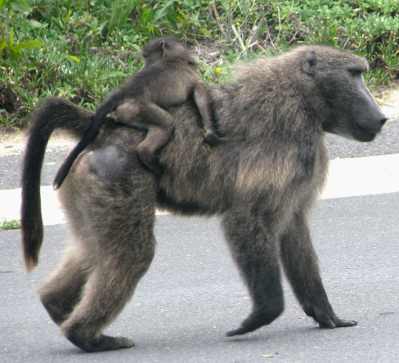
Quizzy with baby on his back.

21 October, 2012
While the intention of killing Peter and Carpenter, may have been to remove the fission troop and for the rest of the troop to join with the main Da Gama troop, as of 20 October, the small troop consisting of just under a dozen females and young had still not joined, the adults possibly fearing attacks on the young if they did so by, in particular, adult males of the other troop. Without the males for protection, the troop is vulnerable and defenceless including against dog attacks.
They are currently led by Big Mama, one of the original three females Peter started the troop with in 2008.
23 September, 2012
Carpenter and youngster on a rock. From what is being pieced together, given lack of official details, Carpenter was reportedly shot while on a rock.
Quizzy, an alpha male of the Da Gama troop along with Quondi, sits alone in the twilight. He is another male that there are concerns will be killed. For the last two months he has had a foot/leg injury. Paintballing him has hampered its healing.
Carpenter, the remaining male of the Da Gama Park fission troop was killed on 19 September, 2012. Reportedly at Guy Lewis Dam by SANParks, the same place Peter was killed. It has not been confirmed officially, but residents have speculated they were both shot. Previously, baboons killed in terms of the protocols have been understood by the public to have been lethally darted by the vet. The deaths of both the males leaves the small troop of about a dozen of three adult females and young vulnerable.
30 AUGUST 2012
It is confirmed that Peter, alpha male of the Da Gama Park fission troop was culled earlier in the week by SANParks after attempts to trap and dart him failed. Exact day and method are not known. Permission had also been given by WAC based on the recommendations of the BCA for Carpenter to be killed. Removing both adult males will result in the "removal" of this small fission troop of around a dozen. Removing fission troops was recommended as a means of reducing baboon numbers by the head of BRU in 2009.
Peter was an outstanding example of how male baboons care for their young, monitoring staff and residents spoke well of him. The reasons for killing him are conflicting at this stage, but it would appear without credible reasons put forth, this was to accomplish removal of the fission troop.

22 JULY 2012
Although it has been claimed that strict procedures are followed when paintballing the baboons, such as only aiming for the rear of the adult males, eyewitnesses have seen that the young and females were also hit. Often a volley of shots, rather than a single targeted shot is fired. Initially red paint was used, easy to see but this was later changed to a whitish paint drying to translucency, making it harder to see on the baboons' fur.
12 JULY 2012
At the beginning of July 2012, in the interim period before the new service provider begins work on 1 August 2012 baboons in various areas were paintballed by officials employed by the City.
19 JUNE 2012
On 19 June 2012 attempts are made to trap Force and Merlin of the Smitswinkel troop to cull them.
AP O'Riain speaks on 567 Cape Talk radio on 19 June while Dr Jordan is interviewed on the 20 June, 2012. Jenni Trethowan was also interviewed.
While Fred was culled because he raided cars, after his death other males continued to do so. Baboon proofing solves baboons raiding. Killing one raiding baboon does not prevent others from continuing to raid.
iAn attempt was also made on 19 June, 2012 to trap Peter of the da Gama Park fission troop, leaving residents wondering if it is intended to cull him too. If so, this would leave only Carpenter as an adult male and brings the viability of the troop into question. (One of the recommendations by the head of BRU at the 2009 workshop was the removal of fission troops.)
9 APRIL 2012
Nosketi of the Da Gama Park troop sits on a rock, his fur splattered with blue paint from a resident's paintball gun in March 2011. He would be shot in the back by a Fish Hoek resident on 11 November 2011, put down later that day.
The case has been repeatedly postponed. The individual who allegedly shot him reportedly did it in the presence of the service provider staff and had actually stated beforehand he would shoot.
On 9 April 2012, residents many of whom, if not all had, according to Graham Noble, former BLG chairman, shot at baboons before (and in the past would have been liable for prosecution), formed part of a group to shoot at, in particular, baboons on the roofs of houses as well as to move them out the area using paintball guns, a recommendation made by BRU.
Dogs were initially also suggested by Graham Noble but there were protests of a hunt. Another paintball drive is scheduled.
There is increasing concern about the so-called "tools" being incorporated in baboon management as well as the future of the baboons.
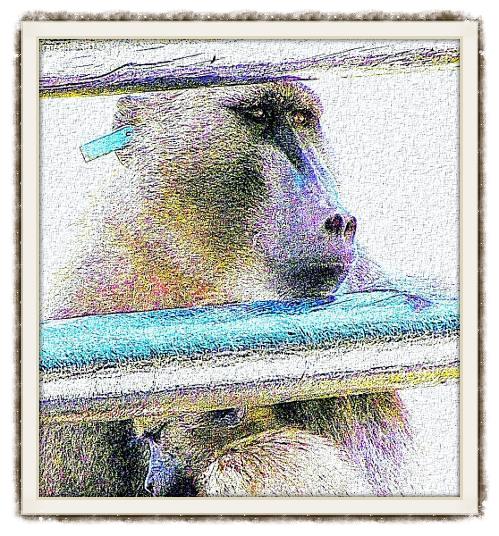
FEBRUARY 2012
In November 2011, head of BRU Justin O'Riain was quoted in the People's Post as saying BRU would recommend contraception for the Da Gama Park troop. An adult male baboon, Carpenter, was castrated the same day. At a public meeting at the Range on 23 February 2012, the vet working with the baboons, recommended castration and sterilisation, also naming this troop. However, it has been confirmed, that if this method is applied it will mean the troop/s will die out.
7 FEBRUARY 2012
Another 4 Baboons culled for raiding in January 2012
In the middle of January, the Constantia baboon the public dubbed "Johnnie Walker", although exhausted, kept on walking and running through the suburbs, avoiding being darted.
It was later reported in the media that he appeared to have made his way back to the mountain.
If so, four other males from the Constantia/Tokai area were not so lucky. Just days before, TK12 and TK14 were culled in accordance with the raiders' protocol. Johnnie's official - though less descriptive and memorable ID is TK11. Names for baboons have been phased out.
It has been said they're too "emotional" rather than "scientific" when "difficult decisions" have to be taken. (Numbers (or eartag colours) also make it harder for the public to identify with or keep track of the baboons. When one TK12 is killed does another assume the number? Also confusing to the public is that baboons in different troops could have the same colour ear tags.
During the last months Constantia baboons have been "chased" with paintballs as an experimental management "tool". It hasn't stopped them raiding.
While males may disperse from their troops, could this pain aversion "tool" also be influencing the males decision to leave the troop?
When bearbangers and bullwhips were advocated by BRU, the public was reassured that these were for noise aversion, even though these "tools" could potentially cause physical injury and they received censure from the NSPCA and SPCA.
But there can be no question that paintballs are pain aversion "tools". They can cause permanent damage, eg eye loss.
It is illegal to hunt baboons. Is paintballing baboons not a form of "hunting"? Why are the monitors not being given proper training in handling the baboons humanely? Baboon Matters has repeatedly offered their methods.
Two males from the Tokai main troop (double orange eartag and red and yellow eartag), deemed to be "raiders" were also culled in January, after being on SANParks land.
Baboons go to BRU after death. What will become of these four culled baboons, given that after culling, alpha male Fred was dissected on the gorily graphic Inside Nature's Giants TV show? (The show also featured a BRU researcher along with a veterinary scientist and an anatomist.)
With paintballs and lethal darts in the air - did Johnnie Walker know it was a matter of "Run, Johnnie, run"?
10 JANUARY 2012
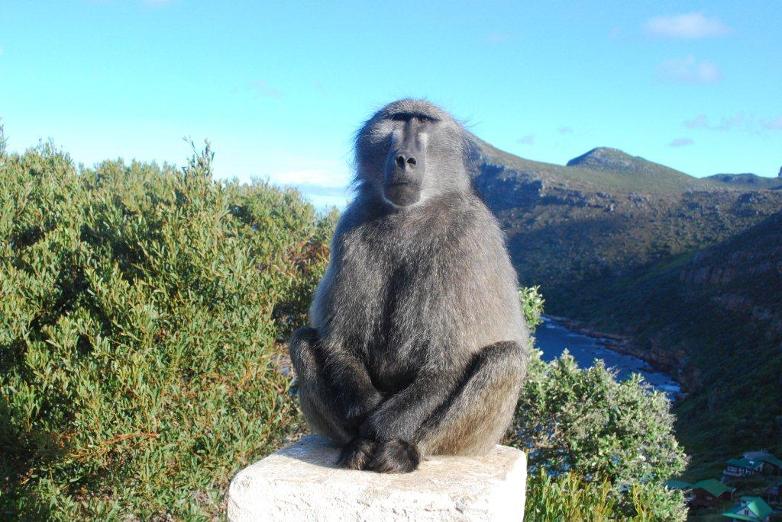
Fred alpha male of Smitswinkel Bay, controversially culled and later dissected on "Rogue baboon - Inside Nature's Giants"
Photo of Fred by Chad Chapman All rights reserved
In March 2011 Fred, alpha male of the Smitswinkel troop was culled for opening unlocked cars and raiding vehicles. His culling was controversial.
The controversy continues.
On 10 January 2012, "Rogue baboon - inside Nature's giants" was aired. It showed the autopsy of Fred by the state vet which included examination of the internal organs, pronounced to be healthy - despite the unhealthy human food diet he was claimed to have eaten by the head of BRU and the fact that 50 projectiles were seen in the one screen of the x-ray before he was cut open.
Occurring at the same time, was a dissection by veterinary scientist Mark Evans and anatomist Joy Reidenberg.
This included emasculation, removing the skin from his hand and arm to examine the working of the tendons, the stuffing of an apple into his cheek pouch to demonstrate its capacity by Justin O'Riain, the head of BRU before the skin was removed from half his face to demonstrate the working of the muscles responsible for facial expressions, sawing open his head to look at the size of his brain.
Many people have refused to watch this graphic dissection, others who did found the treatment of the famous baboon "sickening", "disgusting", "without respect". They have also criticized the "scientific" input.
Veterinary scientist Mark Evans concluded that Fred was "too clever for his own good".
However, was this really the problem?
Fred raided cars with unlocked doors, yet locked cars were not entered, showing that despite his intelligence, his raiding could have been prevented by humans baboon-proofing.
The Smitswinkel troop have been subjected to bullwhips and bearbangers as recommended since 2009 by Dr O'Riain and implemented in the "Simonstown experiment" overseen by BRU in 2009 and praised by him at the July 2009 baboon expert workshop. A resident reported one bearbanger was set off close to Fred in the weeks before his culling.
When baboons die they are taken to BRU, the baboon research unit that gives input on baboon management at all levels. (BRU had input into the protocols under which terms Fred was culled.)
The documentary raises questions.
What happens to other baboons taken to BRU?
Why did BRU allow and participate at the dissection of Fred, a well known baboon killed under controversial circumstances on a series well known for its graphic nature which would obviously be controversial and offensive to many?
Is baboon management increasingly taking a route with a focus on research rather than conservation?
Residents commented earlier in the year that with research being conducted into cross transmission of diseases (given by BRU as a reason to cull Bart), and experimental and even injurious methods of chasing baboons from the urban area being advocated by BRU, the baboons are turning into an open air laboratory.
The dissection of Fred also serves to illustrate that the baboons are indeed being treated as research animals.
Given the input BRU gives to the BCA, WAC, NCC, BLG - although denying they are making decisions about the baboons - it would appear that baboon management is increasingly coming under the influence and direction of the unit.
Note: For answers to their questions about the baboons, residents are being referred to the residents' association, the BLG of which BRU is a founding member, both sharing the goal of total removal of baboons from the urban area. But their questions are often not satisfactorily answered, if at all.
Rather than controversial research projects and experiments, the focus of baboon management needs to shift back to conservation of the baboons.
8 JANUARY 2012
Bafana looks at his injured hand.
Bafana (DG2), a young male baboon stares at a hand injury in October, 2011. The injury was reported 10 days earlier by a resident as "looking like a burst fig, and terribly raw". In June, Bafana's other hand was also cut open and swollen. In March, his leg had a deep gash. Each time these injuries have caused him to limp painfully or not use the limb. Bafana was noticed by concerned residents as not being in the area during December. Since October, 2011 two other adult Da Gama Park males have died.
3 JANUARY 2012

Eric and family
Photo courtesy Baboon Matters. All rights reserved.
The decomposing body of a male baboon in found in Kommetjie. This is failed to be confirmed by vets, but is suspected by a number of people including monitors to be that of Eric as no other males are missing from that troop.
30 DECEMBER 2011
TK4, a baboon from the Tokai troop that landed up in Sea Point was captured and castrated on 30 December, 2011.
Baboons are tagged, collared, screened for cross-transmission of diseases (previously given as a reason to cull Bart by the baboon research unit), culled and castrated. Residents are commenting that the baboons increasingly seem like part of an open air research laboratory, rather than free-ranging wild animals that are protected as a "natural heritage" of the Cape Peninsula.
Also giving credence to this perception, is that requests for information or data about the animals by residents, have frequently not been answered, for example the attempted relocations of males to other troops (the third capture option of the dispersing male protocol). The research unit claims this as a pioneering success yet is unwilling to release data to the public that would prove it.
23 DECEMBER 2011
For a number of days, residents were concerned that they had not seen Eric, former leader of the Slangkop troop. Jenni Trethowan of Baboon Matters called him the Peninsula's most famous baboon.
It was confirmed on 23 December by the City vet upon enquiry, that he has been missing for two to three weeks. Monitors last saw him at the end of November.
10 DECEMBER 2011
Carpenter.
During a residents' meeting on 11 October, 2011 convened by City representatives, see below, it was stated by the vet that no baboons - males or females - would be sterilised as it would have detrimental effects on both males and females.
At the meeting in Da Gama Park Dr Jordan stated:"We have looked at the possibility of sterilisation and there are problems associated with sterilisation.
Number one, if we sterilise the females and they don't produce babies and they don't come on heat, then the males will start roaming. If we sterilise the males, the females will be forever on heat and you'll have these red bums and they will become bigger and bigger and they will actually be huge advertising boards for baboons from outside. Plus if you sterilise a whole troop, male and female, because that was one of the other things that were mentioned, it's said that we're taking away one of the basic structures of baboon behaviour and that is actually having a family. Then you might as well sterilise them because you're taking away that what makes them …
(An interjection to correct “sterilise them” to "euthanase them")
Dr Jordan: -“euthanase them”
Ja, you could rather euthanase them instead of letting them live a life that to them won't be a baboon life, so in a way sterilisation's not on the cards tonight either."
Comment by Dr Elzette Jordan in Meeting convened by City representatives for residents 11 October, 2011 held in Da Gama Park
However, a month later on 15 November, 2011 Carpenter (above), one of two males in a small fission troop, was eartagged, renamed as DG4 - baboon names are being replaced only with numbers - and castrated on the same day as AP O'Riain, head of BRU the baboon research unit, was quoted in a newspaper saying that "BRU will make recommendations to implement contraception methods" in the Da Gama Park troop. ("Local man shoots baboon,"Peoples Post, Daleen Fouche, 15 November, 2011)
The question was asked if sterilisation was implemented would this not mean that the troop eventually would die out, a relevant question as AP O'Riain had in 2009 during the baboon expert workshop, publically made recommendations that fission troops be removed, whole troops be selectively removed (i.e culled) and that baboon numbers be reduced and fewer troops managed (see photos below.)
The dispersing male and repeat raiders protocol of August 2009 headed "prepared by BRU" had also advocated sterilisation and castration as management options. Culling, termed "euthanasia", had been options on the protocol from the 2nd to 4th captures following eartagging of the baboon in the first capture. (A fission troop is the result of a male successfully dispersing and starting his own troop.) The dispersing male protocol would be followed in June 2010 by the individual raiders protocol which had further reaching criteria and could also target alpha males as it did in the case of Fred.
BRU also made recommendations for the use of bearbangers and bullwhips at the workshop. (below)
Aside from the fact that baboons continue to be culled, given the relatively low numbers of baboons, that have shown little increase over a decade, residents are growing increasingly concerned about the future of the Peninsula baboons as well as the use of aggressive tools such as bullwhips, bearbangers and paintballs and other "tools".
At the meeting in Da Gama Park a "vision" of total removal of baboons from the urban area was introduced - which was the longstanding goal of BRU and some residents including in the BLG, publically presented as a residents' association but of which BRU is a founding member. Removal of baboons from the urban area was not an official view previously in baboon management on the Peninsula which focused on baboon-proofing and waste management.
Total removal of baboons is not a view held by many residents or many officials as achievable given that baboon home ranges and urban layout of the Peninsula, means they will occasionally pass through an area, even with well trained monitors and should not be hurt or killed for doing so.
Suggestions/approval for "tools" were asked for at the Da Gama Park meeting. One resident suggested using electric shock collars for the monitors to activate to give the male baboons a "massive" shock if in a house - a preliminary copy of the minutes of the meeting circulated to some residents stated that electric shock collars would be investigated.
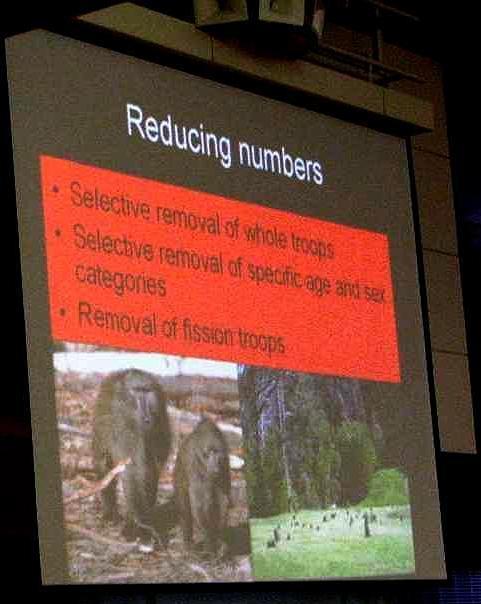

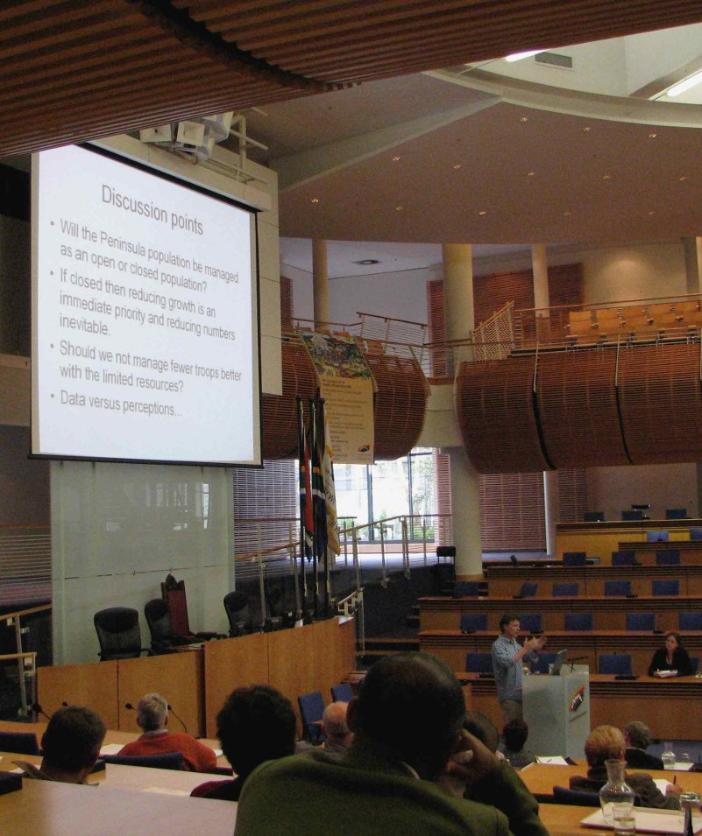
18 NOVEMBER 2011
It is confirmed on 18 November in response to Baboon Matters' question that another baboon TK7 (previously known as Mike) from the Tokai troop had been culled. On the 3rd November he had been reported in the newspaper as visiting Lavender Hill from where he was cage trapped. Again, concerned residents were not informed of the intention to cull him when asking about his status.
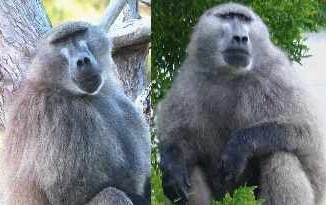
Nosketi (shot, then put down the same day) and George (killed by dogs) adult males of Da Gama Park troop
15 NOVEMBER 2011
In the month that the Da Gama Park troop loses two of its males, AP O'Riain of BRU is quoted in the People's Post, in an article entitled "Local man shoots baboon" saying "BRU will make recommendations to implement contraception methods in this troop." The troop consists of approximately 30 baboons. Such a recommendation in a troop that shows little or no growth due to human and dog induced fatalities, could negatively impact the viability of this troop.
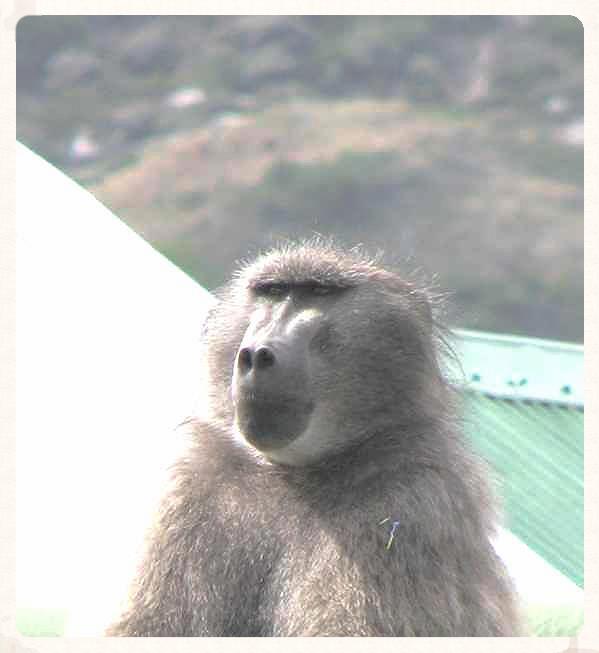
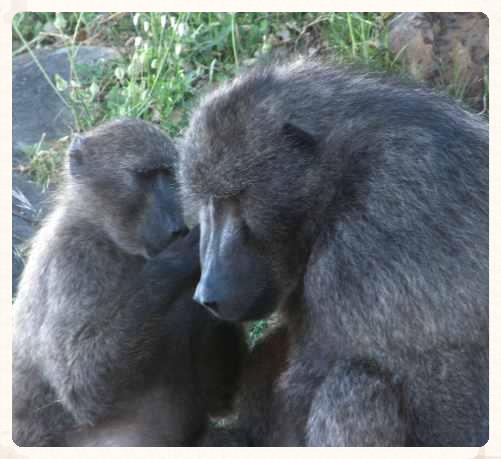
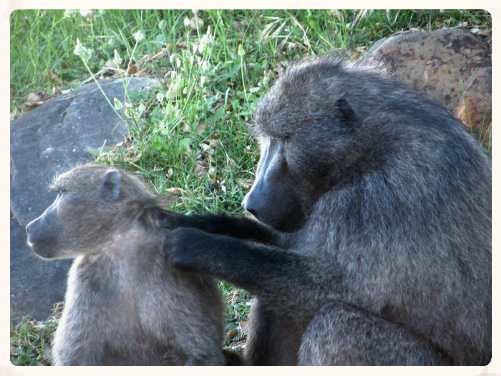
Nosketi of the Da Gama Park troop being groomed by and grooming female.
Noskethi was shot by a 77 year old Fish Hoek resident on 11 November, 2011, later put down by vet.
12 NOVEMBER 2011
On 11 November 2011 Nosketi, an adult male of the Da Gama Park troop was shot by a Fish Hoek resident. NCC staff saw the baboon exit the house, allegedly followed by the elderly man who shot him. Nosketi was later put down.
Ironically, Nosketi was shot the day Table Mountain was announced provisionally as one of the seven wonders of nature, Chacma baboons roaming the lower slopes of Table Mountain before the Cape was settled and also considered a natural heritage.
Nosketi survived being shot with a .22 in 2009. Nosketi was known as a gentle baboon who avoided confrontation.
This is the second death of a Da Gama Park adult male in less than a month. Former alpha male George was killed by two dogs, one of which was a pitbull, in Da Gama Park on the 17th October 2011.

George, former alpha male of the Da Gama troop killed by dogs on 17 October, 2011
(Photo 2006)
27 OCTOBER 2011
On 17 October 2011 George, the former alpha male of the Da Gama Park troop, still commonly referred to as "George's troop" was yet another baboon featured in the ITV production released in 2011, "Baboons with Bill Bailey" that has died in recent months.
In March and July respectively, Fred, alpha of the Smitswinkel troop and Jimmy of the Waterfall troop were culled according to the controversial individual raiders protocol.) All were from the greater Simonstown area troops.
It was alleged by some residents that dogs had attacked George in the Da Gama Park residential area. Conflicting opinions from those in the area said either 2 pitbulls or 2 alsations were involved.
No confirmation from the BLG was available until a local paper reported on the 27th October that the SPCA had said one of the dogs was a brown pitbull. The report stated no action would be taken against the dogs or their owners.
George died a week after a meeting was convened in the area by a ward councillor with City representatives on 11 October, 2011.
George was attacked by small dogs earlier in his life, but survived when men came to his rescue. His father Eric, the oldest baboon in the Peninsula has survived two dog attacks.
Like other baboons, George had also been shot. In 2009, a pellet lodged on his spine, caused him to painfully limp for many months. Jenni Trethowan dedicated her book 'Beast or Blessing' to George.
At nearly 20, George was easily recognized by residents. George provided a stabilising influence in the troop. He could often be seen surrounded by youngsters.
18 OCTOBER 2011
Eyewitness report of paintballs being used on baboons in Constantia area, with frightened animals not knowing where to run.
17 OCTOBER 2011
George, former alpha male of the Da Gama troop killed by dogs on 17 October, 2011
11 OCTOBER 2011
A meeting was convened in the Da Gama Park area by the local ward councillor Simon Liell-Cock (working together with the BLG representative for the area) and City representatives to promote the "vision" of total removal of baboons from urban areas and also to seek options and resident approval for other management "tools".
This approach appears a departure from the emphasis on baboon proofing and waste management with monitors herding the baboons.
(The NCC service provider presentation included bullwhips, bearbangers, tagging and electric fencing. The NSPCA has censured bullwhips and bearbangers, yet they have continued to be used in some troops. Electric fencing is controversial, while tagging is the first step in identifying raiders and can lead to culling.)
This "vision" of total removal of baboons from urban areas using aggressive methods dates back to 2009 when it was originally implemented in the "Simonstown experiment" overseen by AP O'Riain in June 2009 to chase baboons out the urban area.
It was endorsed by him at the July 2009 baboon expert workshop (where he also first suggested the culling of baboons during a presentation advocating reducing baboon numbers.) AP O'Riain has continued to promote bullwhips and bearbangers - at the same deriding the humane methods of Baboon Matters.
The first culling protocol "action plan for repeat raiders and dispersing males headed "prepared by BRU" would be introduced in August, the same month that NCC took over the contract from Baboon Matters. BRU, the baboon research unit is a founding member of the BLG in 2010 which also has as a goal total removal of baboons from the urban area.
The NCC service provider gave a presentation that included bullwhips and bearbangers which they have introduced into various troops such as the Smitswinkel, and Waterfall troops despite censure from the NSPCA as well as residents.
It was stated at the meeting that methods were not working. However, monitors have not been given proper training in assertive handling of the baboons. Some are afraid of the baboons, which does not facilitate handling them effectively. Nor have monitors been trained in the effective methods of Baboon Matters.Baboon Matters', the previous service provider, used shouts and whistles and baboon vocalisation to move the baboons to natural foraging, moving them in a cohesive unit rather than bewildering and causing them to scatter as occurs in the case of more aggressive means.Jenni Trethowan of Baboon Matters, the previous service provider issued a challenge to allow monitors to use her methods and see what the efficacy rates are, before aggressive forms of chasing are implemented:"I would like to suggest: We, Baboon Matters did training at Pezuela and in Barrydale. They enjoyed a 98% success rate using our method, that is that the monitors are assertive.They're not aggressive. Nobody has to be aggressive. They are assertive. ...They are trained well.And they enjoyed a 98% success rate . Before you need to investigate more “tools” the monitors need to be trained so that they are operating properly. We've offered that to NCC, and on a budget of 9 million not 7 million - 9 million, we are told there is no money available to train the monitors to be effective.My challenge to you Sir, is that first of all NCC takes the money out of their budget, they train the monitors using our methods and then see what the efficacy rate is.Secondly looking at your strategy. We have spoken about holding the line and I have said, based on my experience here, holding the line in Welcome Glen is not a strategy that will work. You persist in trying to hold the line. The line is badly positioned and again i've offered advice , I've offered experience – it's been ignored.So before you start investigating more tools, things like whips, things like bearbangers, things like paintball guns first of all get the contractor working effectively..."Although having much experience in handling the animals over the last years and able to give valuable input, also recognized by the public as having a deep concern for the baboons, it was made to appear as though Trethowan was not welcome. A number of the residents found this treatment "shocking".
6 OCTOBER 2011
In an article in October 2011 Full Circle magazine the Baboon Liaison Group (BLG) recommended that a similar approach be taken as recommended by the Humane Society of the USA for bears.
While recommendations for "educating" residents and businesses to baboon proof have long been urged by various parties along with law enforcement for failing to do so, the BLG's further recommendations of "education" for baboons, citing experts using aversive conditioning such as "rubber bullets, pyrotechnics (fireworks) and pepper spray to change unwanted bear behaviour without killing the bear" shows according to some a lack of research and concern for the baboons.
Despite both species raiding human derived food in urban areas, as do other animals like foxes, raccoons and squirrels, baboons are not bears.
One reason alone is the vast size difference. Adult male baboons are considered the largest baboon species and weigh up to around 40 kgs, females half the size and infants and juveniles considerably less. Adult male black bears which are considered a medium sized bear weigh up to 250kg, the adult male grizzly up to 410 kg and Kodiak bears, the largest of the bear family may reach 680 kg.
Additionally baboons are not seen as predators of man. Bears are also generally solitary, apart when together as mother and cubs, Baboon troops in the Peninsula comprise anything up to 40 or so individuals, most of whom are infants, young and females who are easily traumatized.
The article is seen as irresponsible by also sending a message to residents that hurting baboons is permissible to change "unwanted behaviour" - shortly following publication of the article one resident was allegedly seen baiting the baboons with food, then shooting at them with a pellet gun.
The baboons already routinely experience cruelty from residents as evidenced by numerous pellets and projectiles found in them when x-rayed, also showing that pain aversion has not discouraged them entering the urban areas in the past. Fred, alpha male of the Smitswinkel troop was found to have at least 14 airgun pellets and 70 pieces of birdshot at the time of his death.
BRU, the baboon research unit stationed at UCT, is also a member of the BLG which is generally publically portrayed as being a residents' representative organisation. Both share a goal of total removal of baboons from urban areas. This view is not shared by all residents.
The head of BRU has for the past two years recommended the use of bearbangers and bullwhips while deriding the humane use of whistles and shouts used by the previous service provider, Baboon Matters.
NCC, the service provider since August 2009, has increasingly failed to use these humane methods which, together with using the holding the line method has undermined the monitoring programme. If these methods are used by monitors previously trained by Baboon Matters, they still work well.
Despite NSPCA and SPCA censure of aggressive techniques for baboons, NCC continues to attempt to introduce bearbangers and bullwhips to troops such as the Smitswinkel and Waterfall troops. They are training monitors in paintball markers, a method that risks causing injury to baboons including loss of eyes.
The question remains, why are aggressive means that can injure baboons being advocated or used when humane methods work well?
SEPTEMBER 2011
A meeting was called for by Councillor Elizabeth Brunette and representatives of the Baboon Conservation Authorities (BCA), the Constantia Property Owners Association, and surrounding wine farms to discuss the issues that have arisen as a result of the baboon troops living in the area.
A City media release dated 22 September said that "All attendees agreed upon a shared vision: to ensure a sustainable baboon population living on the outside of the urban edge on natural land. A smaller committee has been formed to handle ongoing issues and ensure action is being taken where necessary. This committee will have regular contact with all of the relevant roleplayers.
The following key points were raised at the meeting:
-Available sleeping sites for baboons within the urban area were identified and the specific land-owners (be it authorities or private land-owners) were directed to clear these sites.
-There is a general lack of awareness and knowledge among residents, thus resulting in potentially dangerous or traumatic situations. An education drive is necessary to ensure that residents understand their responsibilities."
15 JULY 2011
Another collared male, Jimmy, was culled on 15 July 2011, in terms of the protocol. When Fred was culled in March, Jimmy was presented as being given a chance to be alpha male.
At the same meeting, the Wildlife Advisory Committee, with the evidence put before them, gave permission for Tokai adult male baboon, TK8, or Oswald to be culled. Again, residents were not informed about the cullings prior to them occurring.
Evidence presented to the Wildlife Advisory Committee comes from the service provider, NCC, BLG members including BRU, residents' affadavits, vets.
1 JUNE 2011
Taking x-rays during an autopsy reportedly carried out in the previous week, the state vet found the body of Fred, the baboon culled in March, carried at least 14 airgun pellets and 70 pieces of birdshot at the time of his death, including in the head.
Many of the Peninsula baboons in residential areas have previously similarly been found by vets to be riddled with pellets, birdshot and even bullets during routine x-rays.
25 MARCH 2011
Fred, alpha male of the Smitswinkel troop is trapped and killed by a vet following instructions from the Baboon Operational Group and permission from Cape Nature Wildlife Advisory Committee.
It is claimed this is carried out on the basis of continuous raiding and aggression towards monitors. On hearing that he is about to be trapped and killed that day, a number of people, urgently contact officials involved to plead for him not to be killed - in vain.
Concerns exist that more baboons will be targeted on the same basis.
Some of the problems currently associated with the monitoring program are lack of training for the monitors in handling the males and in being given strategies that work, instead using faulty strategies like holding the line and aggressive monitoring techniques.
Receiving numerous complaints from residents about baboon presence, Jenni Trethowan has consistently made herself available for training the monitors and helping sort out the problems, but her offers of help have with few exceptions not been utilised.
12 JANUARY 2011
Article published on Times Live and online publications reporting that baboons have helped Western Cape farmers discover a new sweeter variety of mineola (soft citrus).
For several years farmworkers on a farm near Citrusdal noticed that a troop of baboons on the Western Cape farm would return and eat all the fruit off one particular tree in an orchard of thousands. The farm is owned by brothers Alwyn and Gerrit van der Merwe who in 2010 won the most prestigious agricultural award in South Africa for farmers of the year.
Tests were done and reveal that the fruit is sweeter and also ripens at least three weeks earlier, a desirable quality for the export market.
As the next step, shoots from the tree have been grafted into root stock and within several years it is hoped that this new variety will take its place on the consumer's table.
1 JANUARY 2011
Article published on Times Live quoting City vet as saying City of Cape Town has given permission for bear bangers to be used for troops in the Simonstown area.
28 DECEMBER 2010
Article by Dr Justin O'Riain of BRU appears in Cape Times dated 28 December 2010, in which, despite NSPCA censure of the method, he again attempts to motivate for use of bear bangers in Peninsula troops supposedly to deter raids. He claims success of "Smitswinkel experiment" whereby the troop was chased used bullwhips and bearbangers.
However, this "success" as a raiding deterrent is disputed as a number of articles show that Fred, Alpha male of the Smitswinkel troop continued to raid vehicles, picnic and camp sites and a restaurant.
Bear bangers terrify the animals as well as resident's pets and are not a deterrent to raiding. Baboon proofing and well-trained monitors using humane methods work well.
Baboon Matters monitors were trained to herd the animals out of residential areas using assertive whistles, shouts and a particular vocalization.
While the previous methods were de-emphasized under the new service provider management and strategies such as holding the line were used, they could not work in certain areas. (Bear bangers, bull whips and holding the line were all originally used with the Smitswinkel troop in a resident initiative in June 2009, methods publically endorsed by Dr O'Riain at the Baboon expert workshop in July 2009, which process he states in the article BRU "assessed" .)
Dr O'Riain claims that the previous humane methods used by Baboon Matters are failing. However, they are only failing because they have often failed to be used. When monitors trained by the previous service provider still use them, they still work.
The Smitswinkel troop has a unique linear range with natural foraging and if any troop should have been able to be stopped from raiding and herded into natural foraging it would be this one, yet they continued to raid.
Dr O'Riain advocates the use of bear bangers for the Da Gama Park troop (in the Simonstown area), but like others it does not have a linear range. Their range is intersected by urban development and they would not have a well defined home range to run to.
In the last 18 months this method has attempted to be introduced in other areas several times (along with bull whips) and each time brings an outcry from residents and the SPCA.
7 March, 2010
Baboon Matters, baboon monitoring service provider until July 2009, trained monitors to use a system of assertive whistles, shouts and baboon vocalizations to successfully herd the baboons out of urban areas to forage in the hills.
In an independent initiative by a group of Simonstown residents in June 2009 to chase the baboons out the area, during a time there was insufficient funding for monitors for all troops, they began using bullwhips and bearbangers. Bearbangers and bullwhips were subsequently endorsed in a BRU presentation at the 2 July baboon expert workshop.
Bullwhips were attempted to be introduced into other troops but caused an outcry after an adult male was traumatised when a monitor allegedly lashed out towards him. The local SPCA CEO, Allan Perrins, condemned the use of "Neanderthal" management techniques. Whips also sent a wrong message to residents who were not adverse to hurting baboons with them.
Whips were withdrawn for all but the SImonstown troop which were reportedly to use horsewhips only as a short pilot study and report results back to the SPCA.
However, in December 2009 both CapeNature and SANParks approved the use of horsewhips for other troops supposedly as "noise aversion" with CapeNature representative Natasha Wilson and BMT chairwoman claiming they would be used under strict control (something that is not possible seeing as monitors are mostly unsupervised in the field).
During May 2010 in the same month the head of the research unit was presenting a lecture on the use of bearbangers, residents in various areas were startled by the sounds of bullwhips and bearbangers and saw baboons scattering in terror. The introduction of these methods had not been approved with the SPCA.
At this time several of the male baboons began limping painfully for weeks, prompting some residents to be concerned they had perhaps been struck.
15 February 2010
The monitoring contract from 1 Feb-30 June 2010 was again awarded to Dean'Ferreira's Nature Conservation Corporation.
A City tender for this contract had asked for quotes to "remove, relocate and/or euthanize" dispersing males. (The quota given was 4).
A local newspaper article published on the 2nd February claimed a man living at a homeless shelter in Simonstown had been pushed by a baboon and fell off a ramp outside the dormitory on Thursday, seemed to recover and died on Sunday, 1 Feb.
While internet publications quickly picked up on this seemingly sensational item of "baboon kills man", it would emerge that no one had seen the baboon actually push the man. He had run out of the domitory after someone had poured a jug of water over him. The man was found lying on the ground.
Residents at the shelter are known to feed the baboons which naturally encourages them to the area. Dormitories, like other residential properties, need to be secured against baboon entrance i.e. burglar barred windows and security gates over open doors.
According to reporter Tammy Petersen who wrote the first article, Wilf Nussey deputy chairman of the home's board contacted the paper.
The baboon Jimmy, was then captured and eartagged. Capture and eartagging are the first steps of the culling protocol. Culling can occur from the 2nd to 4th capture.
All Content Copyright 2009-2011
All Rights reserved L Thomas
No portion of content may be reproduced in any way without written permission